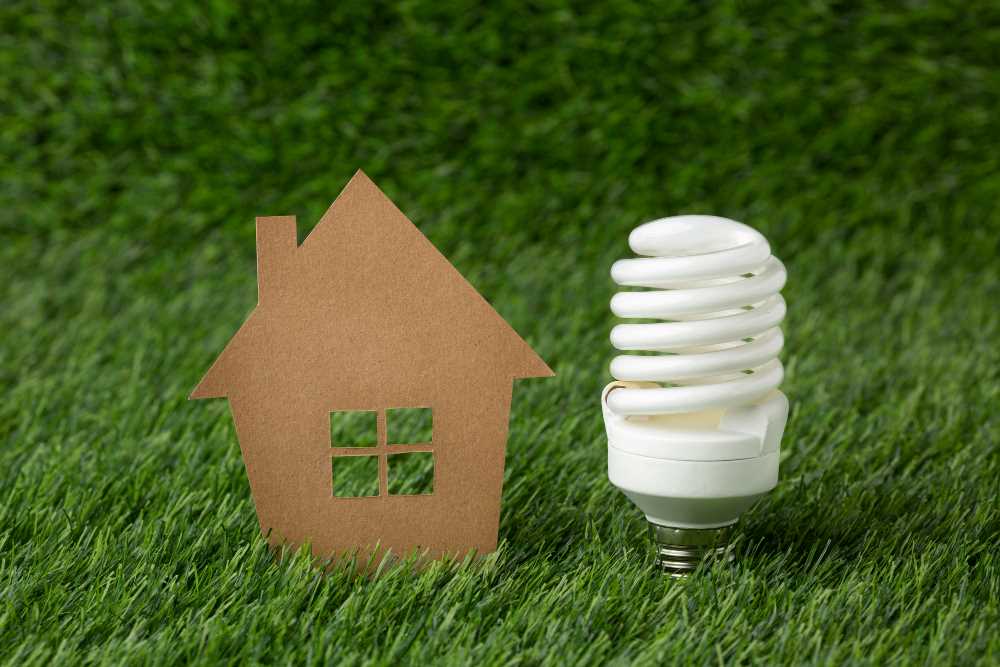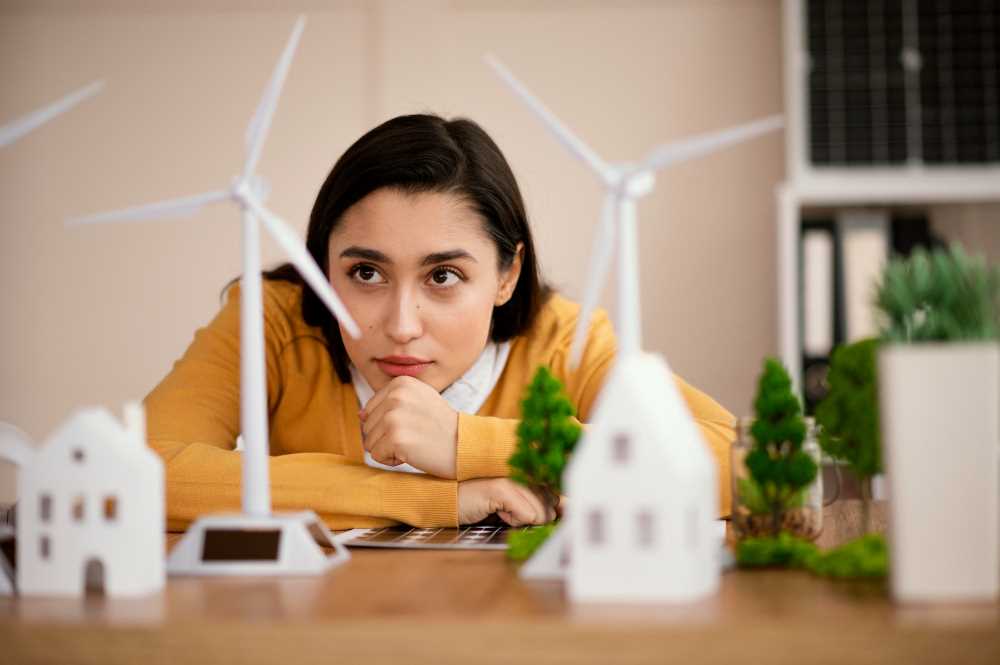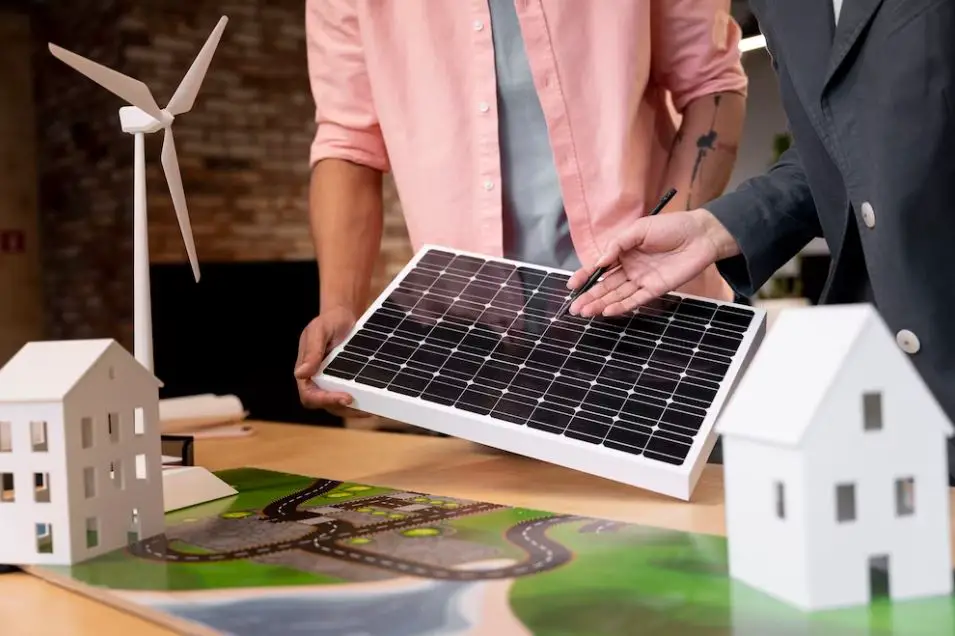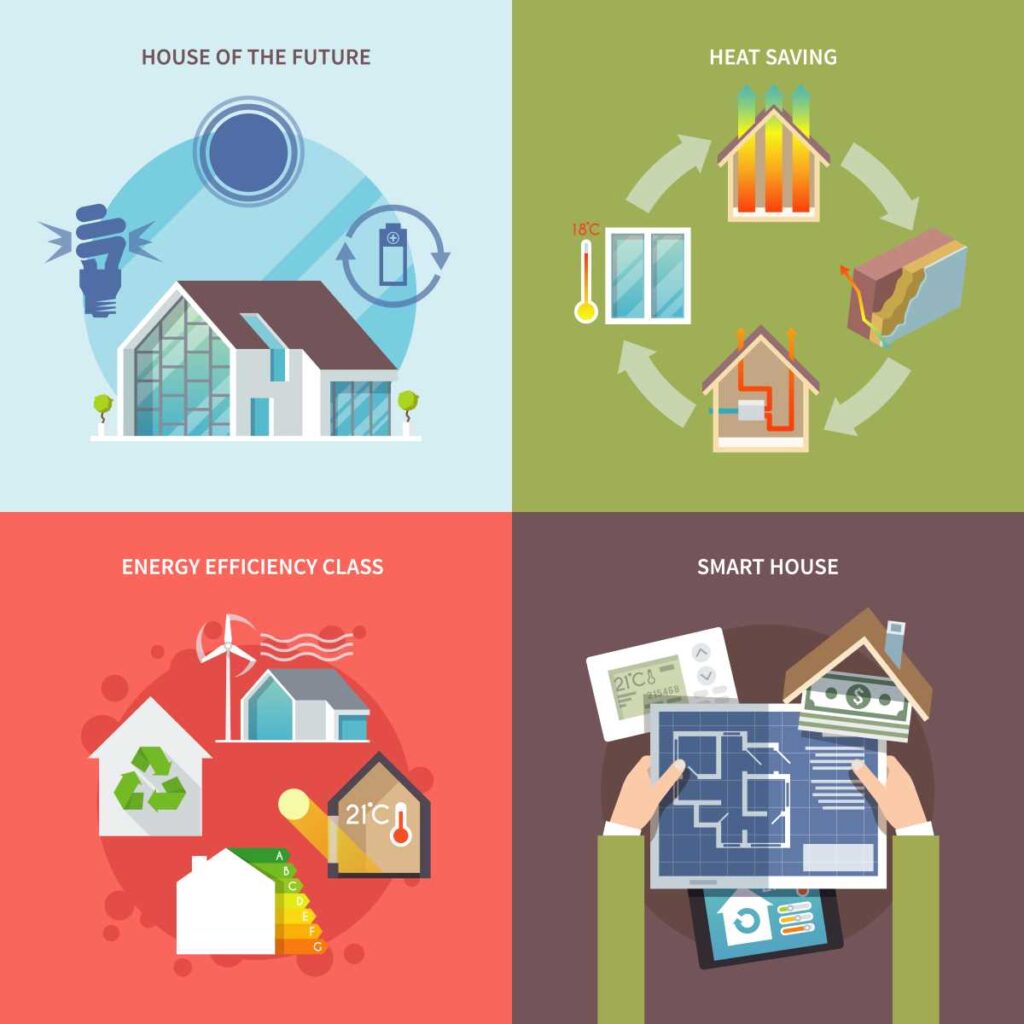Energy-Efficient Home Improvement Tips: Cut Your Energy Bills in Half

As a homeowner, you’re probably always looking for ways to save money and improve the comfort of your home. Energy efficiency is one area that many homeowners overlook. You can save money on your energy bills, increase the comfort of your home, and reduce your carbon footprint by making energy-efficient home improvements.
In this guide, we’ll look at why energy efficiency is important for homeowners, the benefits of making energy-efficient home improvements, and an overview of the topics covered in this post.
Regular maintenance and upgrades can help existing heating and cooling systems run more efficiently. Simple maintenance tasks like changing air filters and cleaning ducts can boost system performance and lower energy consumption.

Table of Contents
Why is Energy Efficiency Important for Homeowners?
Energy efficiency is important for homeowners for a variety of reasons. To begin with, energy-efficient homes are less expensive to operate. You can save money on your monthly energy bills by reducing your energy consumption.
The average homeowner spends $2,200 per year on energy bills, according to the US Department of Energy. You can reduce this cost by up to 30% by making energy-efficient improvements to your home.
The comfort of your home is also improved by energy efficiency. You can maintain a consistent temperature throughout your home regardless of the season by reducing draughts and improving insulation. This can also help to reduce the strain on your HVAC system, extending the life of your equipment.
Finally, energy-efficient homes are less harmful to the environment. You can reduce your carbon footprint by reducing your energy consumption. This is particularly critical as we work to combat climate change and reduce greenhouse gas emissions.
The Advantages of Energy-Efficient Home Improvements
Making energy-efficient home improvements has a number of advantages. Here are a few examples:
Lowering your energy consumption will result in a reduction in your monthly energy bills.
Increased Comfort: Energy-saving improvements can improve insulation, reduce draughts, and improve ventilation, making your home more comfortable all year.
Improved Indoor Air Quality: Improvements such as air sealing and ventilation can improve the quality of the air you breathe, which is especially important for people who suffer from allergies or asthma.
Home Value Increase: Energy-efficient homes are in high demand, and making improvements to your home can increase its value.
Reduced Carbon Footprint: By lowering your energy consumption, you are lowering your carbon footprint, which is beneficial to the environment.
We’ll go over the following topics in this post:
Conducting an Energy Audit: We’ll explain what an energy audit is and why it’s important, as well as offer advice on how to find a professional energy auditor or perform a DIY audit.
Insulation and air sealing: We’ll explain how insulation and air sealing work to improve energy efficiency, give you an overview of different types of insulation materials, and give you advice on how to choose the right insulation for different parts of your home.
Heating and Cooling Upgrades: We’ll explain how heating and cooling upgrades can improve energy efficiency, give you an overview of different types of heating and cooling systems, and give you advice on selecting the best system for your home and climate.
Lighting and Appliance Upgrades: We’ll explain how lighting and appliance upgrades can improve energy efficiency, give you an overview of different types of energy-efficient lighting, and give you tips on how to choose the right lighting for different areas of your home.
Renewable Energy Sources: We’ll explain how renewable energy sources can improve energy efficiency, give an overview of different types of renewable energy sources, and provide advice on selecting the right system for your home and climate.
Homeowners benefit from energy-efficient home improvements in a variety of ways, including lower energy bills, increased comfort, improved indoor air quality, increased home value, and a lower carbon footprint.
In this guide, we’ve explored why energy efficiency is important for homeowners, the benefits of energy-efficient home improvements, and provided resources.

Conducting an Energy Audit
What is an Energy Audit?
An energy audit is a process that assesses a home’s or building’s energy efficiency. An energy audit is performed by a trained professional or a do-it-yourself homeowner who examines the home’s energy use, insulation, heating and cooling systems, appliances, and lighting.
An energy audit’s goal is to identify areas where energy is being wasted and to make recommendations for improvements that will increase energy efficiency.
Energy audits are classified into three types: basic audits, walk-through audits, and comprehensive audits. The most basic audits involve a visual inspection of the home to identify obvious areas of energy inefficiency.
Walk-through audits include a more thorough inspection of the home and may include the use of specialized equipment to measure energy consumption.
Comprehensive audits are the most in-depth, involving a thorough examination of the home’s energy use, including the use of specialized equipment and testing.
Why Conduct an Energy Audit?
Homeowners should consider conducting an energy audit for a variety of reasons. To begin with, an energy audit can assist in identifying areas where energy is being wasted, which can result in higher energy bills. By identifying these areas, homeowners can take steps to improve their homes and save money in the long run.
Second, an energy audit can assist in identifying areas of the home’s energy efficiency that can be improved. By making these changes, homeowners can improve their home’s comfort while also lowering their carbon footprint.
Upgrades could include adding insulation, replacing inefficient appliances, or switching to a more energy-efficient heating and cooling system.
Finally, by conducting an energy audit and improving their home’s energy efficiency, some homeowners may be eligible for energy rebates or incentives. These rebates and incentives can help defray the costs of making energy-efficient improvements.
Professional Energy Auditors vs. DIY Audits
Homeowners can conduct an energy audit themselves or hire a professional energy auditor. Both options have advantages.
Professional energy auditors have specialized training and equipment to conduct a thorough audit of the home’s energy use. They can detect areas of energy inefficiency that homeowners may find difficult to detect on their own. They can also make recommendations for improvements that are tailored to the needs of the home.
DIY audits, on the other hand, can be less expensive and more convenient for homeowners. They include a visual inspection of the house as well as the use of simple tools such as a thermometer or infrared camera.
While they may not be as thorough as a professional audit, they can still provide useful information about the home’s energy use and areas for improvement.
How to Conduct a Whole-House Energy Audit
Common Energy Inefficiencies Found During Audits
Several common energy inefficiencies may be discovered during an energy audit. Inadequate insulation is one of the most common. Uninsulated homes can lose heat in the winter and gain heat in the summer, resulting in higher energy bills and decreased comfort.
Air leaks are another common source of inefficiency. When air escapes from the home through cracks and gaps in the walls, floors, and ceilings, it is called an air leak. As a result, the HVAC system has to work harder to maintain a consistent temperature, which can result in higher energy bills and decreased comfort.
Inefficient appliances and lighting are also common sources of energy waste. Incandescent light bulbs and older appliances use more energy than newer, energy-efficient models. Energy savings can be realized by upgrading to more energy-efficient appliances and lighting.
Finally, inefficient heating and cooling systems can be a major source of energy. Older systems may be less efficient than newer models and may require repairs or upgrades. Upgrading to a more energy-efficient system can result in lower energy bills and more comfort.
Finally, conducting an energy audit can assist in identifying areas of energy inefficiency in the home.
Insulation and Air Sealing
How Insulation Improves Energy Efficiency
Insulation is a critical component of home energy efficiency. Insulation can help keep the home cooler in the summer and warmer in the winter by reducing heat transfer between the inside and outside of the home, reducing the need for heating and cooling systems.
Insulation can also help to reduce the amount of energy required to keep the home at a comfortable temperature, resulting in lower energy bills.
Types of Insulation Materials
There are several types of insulation materials that can be used in homes, each with their own set of advantages and disadvantages. Here are a few examples:
Fiberglass: Made of glass fibers, this is one of the most common types of insulation. It is inexpensive, simple to install, and provides adequate insulation.
Cellulose insulation is blown into the walls or attic and is made from recycled paper. It has a high R-value, making it an efficient insulator.
Spray foam is a liquid insulation that expands to fill all gaps and crevices. It has a high R-value and is effective at keeping air out.
Rigid foam insulation is made of foam boards and is used on the exterior of the home. It has a high R-value and can help keep moisture out.
Choosing the Right Insulation for Different Areas of the Home
Different types of insulation are required for different areas of the home. In the walls, for example, fiberglass or cellulose insulation can be used, whereas spray foam or rigid foam can be used in the attic.
To ensure maximum effectiveness and energy efficiency, it is critical to select the appropriate insulation for each area.
How Air Sealing Complements Insulation
Another important aspect of home energy efficiency is air sealing. Air leaks can reduce a home’s energy efficiency significantly by allowing heat to escape in the winter and cool air to escape in the summer.
Air sealing entails sealing all gaps, cracks, and holes in the exterior of the home to prevent air from escaping or entering. Air sealing, when combined with insulation, can help ensure maximum energy efficiency and comfort in the home.
Tips for Finding and Sealing Air Leaks
There are several methods for locating and sealing air leaks in the home. Doors, windows, electrical outlets, and pipes are all common places to look for leaks.
A smoke pencil, which can help identify areas where air is escaping, is an easy way to check for leaks. Leaks can be sealed with caulk, weather-stripping, or spray foam once they have been identified.
Finally, insulation and air sealing are critical components of home energy efficiency. Homeowners can significantly reduce their energy bills and improve the comfort of their homes by selecting the appropriate insulation for each area of the home, ensuring proper installation, and sealing all air leaks.
Working with a professional is essential to ensure that insulation and air sealing are installed correctly and in accordance with local building codes.

Heating and Cooling Upgrades
How Heating and Cooling Upgrades Improve Energy Efficiency
Heating and cooling systems in homes are significant energy consumers, accounting for a significant portion of energy bills.
Energy consumption and energy bills can be reduced by upgrading to more energy-efficient systems. Increased energy efficiency can also result in a more comfortable home, with more consistent temperatures and better air quality.
Types of Heating and Cooling Systems
For homes, there are several types of heating and cooling systems available, including:
Furnaces: These are forced-air systems that heat air that is then distributed throughout the home via ducts using natural gas, propane, or oil.
Boilers are water-based systems that use natural gas, propane, or oil to heat water that is then piped throughout the home.
Heat pumps: These systems use electricity to move heat from the outside air or ground into the home. In the summer, they can also be used to cool the house.
Ductless mini-split systems are similar to heat pumps, but they do not require ductwork. They are made up of one or more outdoor units and one or more indoor units.
Choosing the Right System for Your Home and Climate
It is critical to select the best heating and cooling system for your home and climate in order to maximize energy efficiency and comfort. The size and layout of the home, the climate, and the homeowner’s budget are all factors to consider.
To ensure maximum efficiency, it is also critical to ensure that the system is properly sized and installed.
Smart Thermostats and Their Benefits
Smart thermostats are programmable thermostats that can be remotely controlled using a smartphone or other device. They provide several advantages, including:
Energy savings: Smart thermostats can learn the homeowner’s schedule and adjust the temperature to save energy.
Convenience: Smart thermostats enable homeowners to remotely control their heating and cooling systems, allowing them to adjust the temperature from anywhere.
Comfort: By adjusting the temperature based on the homeowner’s preferences, smart thermostats can help ensure a more comfortable home.
Maintenance and Upgrades for Existing Systems
Upgrades such as duct insulation or switching to a more energy-efficient system can also result in significant energy savings.
Finally, heating and cooling upgrades are an important part of improving home energy efficiency. Homeowners can significantly reduce their energy bills and improve the comfort of their homes by selecting the right system for their home and climate, installing smart thermostats, and performing regular maintenance and upgrades.
Working with a professional is essential to ensure that upgrades and maintenance are done correctly and in accordance with local building codes.

Lighting and Appliance Upgrades
How Lighting Upgrades Improve Energy Efficiency
Lighting can consume a significant amount of energy in a home. Upgrading to more energy-efficient lighting can aid in lowering energy consumption and bills. Energy-efficient lighting also outlasts traditional lighting, reducing the need for replacement.
Types of Energy-Efficient Lighting
Energy-efficient lighting comes in a variety of forms, including:
LED lighting is extremely energy-efficient and can last up to 25 times longer than standard incandescent bulbs.
Compact fluorescent lights (CFLs) use less energy than incandescent bulbs and can last up to ten times longer.
Halogen lighting is a more energy-efficient alternative to traditional incandescent bulbs.
Smart lighting: Smart lighting allows homeowners to control lighting remotely using a smartphone or other device, reducing energy consumption by only turning on lights when they are needed.
Choosing the Right Lighting for Different Areas of the Home
Choosing the appropriate lighting for various areas of the home is critical for maximum energy efficiency and comfort.
The purpose of the room, the amount of natural light, and the desired level of lighting are all factors to consider. Dimmer switches can also help reduce energy consumption by allowing homeowners to customize their lighting.
Energy-Efficient Appliances and Their Benefits
Appliances are another major source of energy consumption in the home. Upgrading to energy-efficient appliances can aid in lowering energy consumption and bills. Energy-saving appliances also provide several advantages, including:
Environmental advantages: Energy-efficient appliances aid in the reduction of greenhouse gas emissions and the protection of the environment.
Energy-efficient appliances can save homeowners hundreds, if not thousands, of dollars over the life of the appliance.
Improved performance: Energy-efficient appliances frequently outperform traditional appliances in terms of comfort and convenience.
Choosing and Using Appliances to Maximize Energy Efficiency
Choosing and using energy-efficient appliances is critical for maximum energy efficiency and cost savings. Here are some suggestions for selecting and using energy-efficient appliances:
Look for the ENERGY STAR label: ENERGY STAR-certified appliances meet the U.S. Environmental Protection Agency’s strict energy efficiency guidelines.
Use appliances sparingly: Use appliances only when necessary, and fill them to capacity whenever possible.
Proper maintenance can help to improve the energy efficiency and performance of appliances. Cleaning air filters and defrosting freezers are examples of such tasks.
Finally, lighting and appliance upgrades are critical components of home energy efficiency. Homeowners can significantly reduce their energy bills and protect the environment by selecting the right lighting for different areas of the home, upgrading to energy-efficient appliances, and using appliances in an energy-efficient manner.
Working with a professional is essential to ensure that upgrades and maintenance are done correctly and in accordance with local building codes.
Renewable Energy Sources
How Renewable Energy Sources Improve Energy Efficiency
Renewable energy sources, such as solar, wind, and geothermal power, have the potential to significantly improve home energy efficiency.
Homeowners can reduce their reliance on traditional fossil fuels, lower their energy bills, and reduce their carbon footprint by generating energy from renewable sources.
Types of Renewable Energy Sources
To improve energy efficiency, homeowners can use a variety of renewable energy sources, including:
Solar energy is the most commonly used renewable energy source in homes. Solar panels, which can generate electricity or heat water, can be installed on rooftops or in other areas with access to sunlight.
Wind energy: Wind turbines, which can generate electricity, can be installed on properties with consistent wind.
Geothermal energy: Geothermal systems heat and cool homes by utilizing the natural heat of the earth, and can be installed using either closed or open loop systems.
Hydro energy: Hydro systems use the energy of flowing water to generate electricity.

Choosing the Right System for Your Home and Climate
It is critical to select the best renewable energy system for your home and climate in order to maximize energy efficiency and cost savings.
Consider the availability of renewable energy sources in your area, the amount of energy required by your home, and your budget.
Working with a professional is essential for determining the best system for your needs as well as ensuring proper installation and maintenance.
Incentives and Financing Options for Renewable Energy Upgrades
Homeowners who want to switch to renewable energy sources can take advantage of a variety of incentives and financing options. These are some examples:
Homeowners may be eligible for a federal tax credit of up to 26% of the cost of a renewable energy system.
State and local incentives: Many states and local governments provide additional incentives for renewable energy upgrades, such as rebates or grants.
Financing options, such as low-interest loans or leases, can assist in making renewable energy upgrades more affordable for homeowners.
Successful Renewable Energy Projects in Homes
Many successful renewable energy projects have been installed in homes across the country. These projects have resulted in significant energy, cost, and environmental savings. Here are some examples of successful renewable energy projects in homes:
Solar panels: Many homeowners have successfully installed solar panels on their roofs, saving significant amounts of energy and money.
Geothermal systems: Geothermal systems have been installed successfully in homes across the country, improving energy efficiency and comfort.
Wind turbines: Wind turbines have been installed successfully on rural properties with reliable wind, resulting in significant energy and cost savings.
Finally, renewable energy sources have the potential to significantly improve home energy efficiency, resulting in cost savings and environmental benefits.
Homeowners can help the environment and their wallets by selecting the right system for their home and climate, taking advantage of incentives and financing options, and learning from successful renewable energy projects.
Importance of Energy-Efficient Home Improvements
Home energy-efficiency improvements are important for a number of reasons. They can, first and foremost, help you save money on your energy bills. You can significantly reduce your monthly utility costs by reducing the amount of energy you consume.
Energy-efficient upgrades can help you reduce your carbon footprint in addition to saving money. You can help reduce greenhouse gas emissions and contribute to a cleaner, healthier planet by using less energy.
Energy-efficient upgrades can also improve your home’s comfort and livability. Proper insulation and air sealing, for example, can help keep your home warm in the winter and cool in the summer, making it more comfortable to live in all year.
Similarly, switching to energy-efficient appliances and lighting can improve your home’s functionality and convenience while also lowering your energy consumption.
Benefits of Each Type of Upgrade
There are several types of energy-efficient home improvements, each with its own set of advantages. The following are some of the advantages of each type of upgrade:
Insulation and air sealing: By reducing heat loss through the walls, roof, and windows, proper insulation and air sealing can help improve your home’s energy efficiency. This can help you save money on your energy bills while also improving your home’s comfort.
Heating and cooling system upgrades can help improve your home’s energy efficiency by lowering the amount of energy required to heat or cool your home. This can help you save money on your energy bills while also improving your home’s comfort.
Lighting Upgrades: Switching to energy-efficient bulbs can help you save money on energy while also improving the quality and functionality of your lighting. This can help you save money on your energy bills while also improving the comfort and convenience of your home.
Renewable Energy Sources: Installing renewable energy systems, such as solar panels or wind turbines, can assist you in producing your own energy and reducing your reliance on fossil fuels. This can save you money on energy bills while also lowering your carbon footprint.
Encouragement to Take Action and Improve Energy Efficiency at Home
Improving your home’s energy efficiency may appear daunting, but it doesn’t have to be. There are numerous simple and inexpensive upgrades that can have a significant impact on your energy consumption and utility bills. Here are some pointers to get you started:
Conduct an energy audit: An energy audit can help you identify areas in your home where energy is being wasted and make recommendations for improvements.
Utilize incentives and financing options: Many local and state governments provide incentives and financing options to assist homeowners in making energy-efficient improvements.
You don’t have to do everything all at once. Begin with small changes, such as replacing incandescent light bulbs with energy-efficient bulbs or caulking air leaks around doors and windows.
Work with a professional: If you aren’t comfortable doing the upgrades yourself, hire a professional who can assist you in determining the most effective and cost-effective upgrades for your home.
To summarize, energy-efficient home improvements can help you save money, reduce your carbon footprint, and improve the comfort and livability of your home.
5 Easy Ways to Guarantee a 50% or MORE Energy Bill Reduction!
RELATED: 7 Ways to Transform Your Old House into a Showplace. READ MORE…
